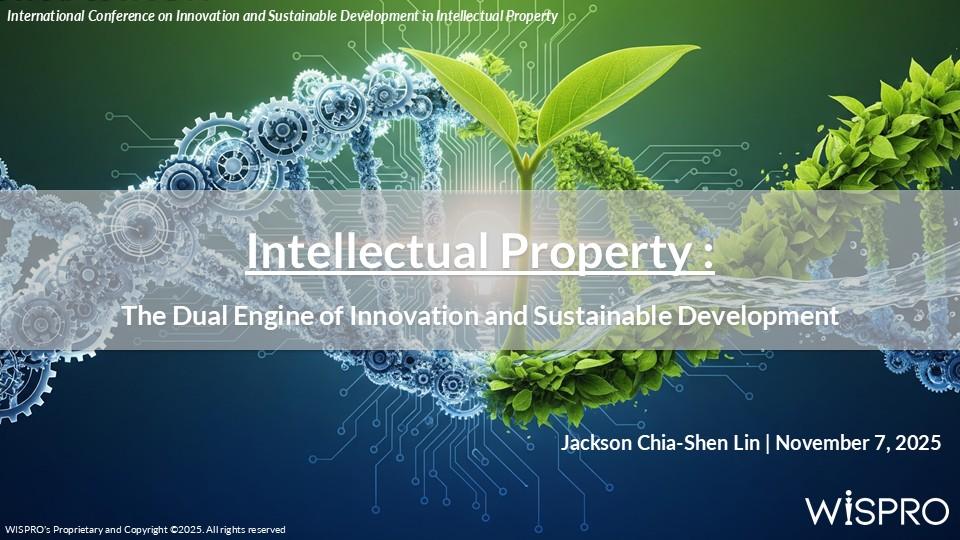A complete framework for navigating the conflict between ESG transparency and IP protection.
When the conversation around sustainability revolves around carbon footprints and compliance, few discuss the critical engine that powers both innovation and trust: Intellectual Property.
At the recent International Conference on Innovation and Sustainable Development in Intellectual Property (NCCU, Nov. 7, 2025), Wispro CEO Jackson Lin shared our perspective on this transformation—how IP must evolve from a passive shield to a dual engine that drives both technological progress and stakeholder confidence.
This is the complete framework for leaders seeking to build a “green moat” that is both competitive and authentic.
The Dual Challenge: Innovate or Be Irrelevant. Be Sustainable or Be Illegitimate.
Modern enterprises face two accelerating headwinds:
-
- The Innovation Challenge: Shorter product lifecycles and rising R&D costs.
- The Sustainability Challenge: Stricter ESG standards and the demand for authentic green credentials.
Innovation without sustainability risks legitimacy.
Sustainability without innovation risks competitiveness.
Success now depends on mastering both dimensions simultaneously.
The Evolution of IP: From Shield to Dual Engine
For too long, IP has been viewed as a static legal defense (a Shield). Its role has evolved. It is now the core mechanism that synchronizes two engines:
-
- The Innovation Engine (The Proof): This is your technology. Your patented green processes, your proprietary circular materials, your trade-secret formulations. This engine makes your claims “Real.”
- The Sustainability Engine (The Promise): This is your brand. Your trademarks, your eco-labels, your design-led commitment to repairability. This engine makes your claims “True.”
IP is the governance model that ensures these two engines move in sync.
Global Momentum: IP Systems Are Demanding Sustainability
This isn’t just a theory; it’s a global policy shift.
-
-
- The EU’s Ecodesign Regulation (ESPR) mandates circularity and repairability, directly challenging traditional patent and design rights.
- The USPTO’s Climate Change Mitigation Pilot (now closed) accelerated low-carbon inventions.
- Japan’s GXTI patent index provides a framework for companies to disclose green innovations, linking IP data directly to corporate strategy.
-
Case Insights: How “Proof” Meets “Promise”
-
-
- Apple (Ecosystem Control): Apple “opened” parts of its Daisy disassembly patents. This wasn’t altruism; it was a strategy to build the high-efficiency recycling ecosystem it needs to meet its own supply chain goals.
- Innolux × ITRI (Asset Creation): A patented process transformed “environmental liabilities” (waste LCDs) into “green assets” (reusable liquid crystal), creating a new B2B circular model.
- Patagonia (Belief as IP): The Worn Wear® trademark protects a circular service (repair, resell), not just a new product. It turns an anti-consumption belief into an IP-protected asset.
- RHINOSHIELD (The Dual Engine): They perfectly integrate both engines: their ShockSpread™ technology (the Proof) enables their CircularNext brand (the Promise).
-
Navigating Friction: The New Governance Agenda
As ESG transparency grows, IP leaders must confront three critical tensions. These are the primary sources of corporate risk and, if managed, opportunity.
-
- Right to Repair vs. Patents: How do you comply with repairability mandates without compromising your core patent-protected ecosystem? This is a direct challenge to business models built on proprietary parts, illustrated by the FTC’s major lawsuit against John Deere over its restrictive software and repair policies.
- Transparency vs. Trade Secrets: How do you meet ESG demands for supply chain disclosure without revealing the trade-secret suppliers and formulations that define your competitive edge?
- Greenwashing vs. Verifiability: How do you protect your brand from greenwashing claims? By using your IP portfolio (patents, data) as verifiable evidence that your marketing claims are true. The risk is no longer theoretical; the UK’s CMA investigation into ASOS and Boohoo for greenwashing highlights that claims without verifiable data are a direct legal and regulatory liability.
Governance—not slogans—is the only sustainable answer.
3-Layer Strategy for Taiwan’s “Green Moat”
We propose a roadmap for IP-ESG integration, moving from policy to corporate action:
-
-
- Policy Layer: Define IP × ESG frameworks and incentives.
- Industry Layer: Diagnose friction points and risks.
- Corporate Layer: Design governance, deploy metrics, and deliver data-backed impact.
-
This is how Taiwan can build its green moat—turning IP from mere ownership to the stewardship of responsible innovation.
Get the “IP Dual Engine” Full Presentation PDF
To explore these concepts in greater detail, including more data, case studies, and the full “IP Dual Engine” model, we invite you to download the complete presentation.
(After submitting the form below, you will receive an email with the attached PDF in your inbox immediately. Wispro respects your privacy.)
Sources & References
-
- (2025) International Conference on Innovation and Sustainable Development in Intellectual Property. ACCUPASS. Retrieved from: https://www.accupass.com/event/2509090823143581778960
- (2025) FTC, States Sue Deere & Company to Protect Farmers from Unfair Corporate Tactics, High Repair Costs. Federal Trade Commission (FTC). Retrieved from: https://www.ftc.gov/news-events/news/press-releases/2025/01/ftc-states-sue-deere-company-protect-farmers-unfair-corporate-tactics-high-repair-costs
- (2024) Fashion greenwashing: investigation into ASOS, Boohoo and Asda. Competition and Markets Authority (CMA). Retrieved from: https://www.gov.uk/cma-cases/asos-boohoo-and-asda-greenwashing-investigation

